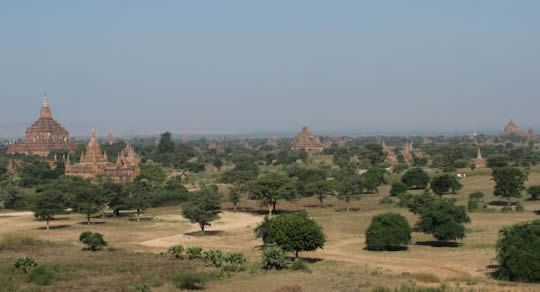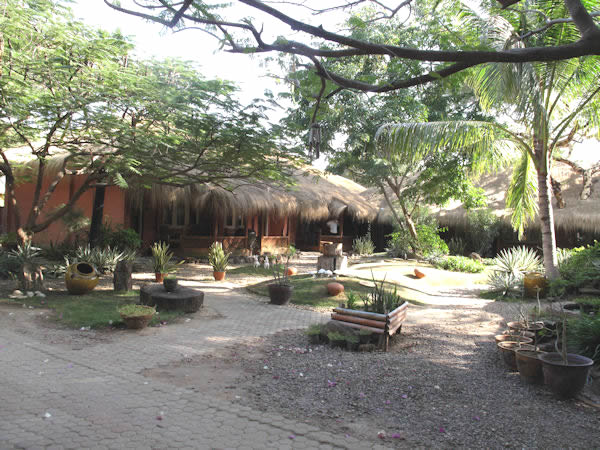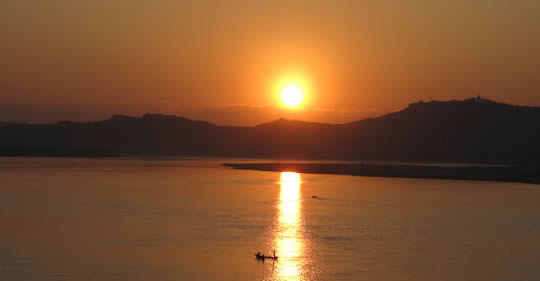

4. In Bagan – 12th Jan 2011

Map of Bagan
4.1 General
Bagan is an ancient city in the Mandalay Division of Myanmar. It is located in the central arid plain on the eastern bank of Ayeyarwady River, 140 km from Mandalay and covering an area of about 16 square miles. It is home to the largest area of Buddhist temples, pagodas and ruins in the world, many of which dating back to the 11th and 12th centuries., There once were an estimated 13,000 monuments which were in all stages of decay and today there are about 2,200 left.
It was reported that an application was submitted by the military junta to UNESCO, but the latter did not designate Bagan as a World Heritage Site because the military junta had haphazardly restored the stupas, temples and buildings, ignoring original architectural styles and using modern materials which bore little or no resemblance to the original designs. Also the junta had constructed a golf course and a paved highway in the area.
Places we visited are: Shwezigon Pagoda, Nyaung U market, Pyat that gyi pagoda, Htilo-Min Lo Temple, Ananda Temple Myinkabar gubyank Gyi Temple and Sunset at Buphaya.
4.2 Nyaung U Market
Nyuang U market is located a couple of miles from Bagan and it is where the majority of the budget hotels are located. The market was busy and stalls were selling vegetables, fruits, meat and fish. The stall keepers were mainly women who still used old hanging balances to weigh their products.
|
|
4.3 Pagodas/Temples Safari in Bagan
In Bagan (Pagan) there are more than 2,000 monuments within an area of about 16 square miles. They are of different sizes and shapes. They are also in varying stages of preservation and disrepair. Some are in total ruins.
We visited five monuments and had to traverse the whole area like in a wildlife safari park!

- Shwezigon Pagoda


Shwezigon Pagoda is located in Nyaung U, a town near Bagan. It is a famous Pagoda completed in 1102 and is architecturally important because it became the prototype for later Myanmar pagodas. It consists of a circular gold leaf-gilded stupa surrounded by smaller temples and shrines. It is believed to enshrine a bone and a tooth of Gautama Buddha.
- Pyatthatgyi Pagoda

It is an old temple in despair. From the roof of this temple, one can have a panoramic view of the “Safari” Park.
- Htilominlo Temple

Htilominlo Temple was built in 1211 during the reign of King Htilomenlo. The temple is 3 - storey tall with a height of 46m and built with red bricks. On the first floor there are four images of Buddha, each facing the cardinal direction of East, North, West and South.
- Ananda Temple

Ananda Temple was built in 1105 during the reign of King Kyanzittha of the Bagan Dynasty. The temple layout is in a cruciform with several terraces leading to a small pagoda at the top covered by an umbrella known as hti, found in almost all pagodas in Myanmar. The temple also houses 4 standing Buddhas, each facing the cardinal direction. The temple is believed to be a fusion of Mon and Indian style of architecture.
- Myinkabar Temple

The name of this temple is connected with the first historical King Anawranto (1044 – 1077) who defeated and killed his half-brother King Sokkate in a single combat on horseback near the banks of Myinkaba stream. Torn by remorse, the King built the Myinkaba to make amends for his deed.
- Lacquer ware factory
|
|
|
|
|
|
Lacquer ware is one of the traditional crafts of Myanmar, dating back to the 11th century. Most of the good lacquer wares are hand-made in Bagan. The basic object is made of bamboo, or a frame wound with horsehair! The lacquering process then begins. After a layer of lacquer is applied, the surface is polished. Several layers of lacquer are applied for each piece.
The artistic work is the next part of the process, where intricate painting is applied. The process is slow for multi-colored pieces, as when each color is completed, it is cleaned and polished before the next coat of paint is applied. In many lacquer wares, gold leaves are also applied.
There is an array of lacquer wares for sale in the factory, like trays, plates, bowls, cup boxes etc…

The hotel we stayed in Bagan
|
|
A male pig hired to impregnate a sow

Sunset at Buphaya on the bank of Ayeyarwady River
Back to pg 2 / pg 3 / Go to Pg 4






